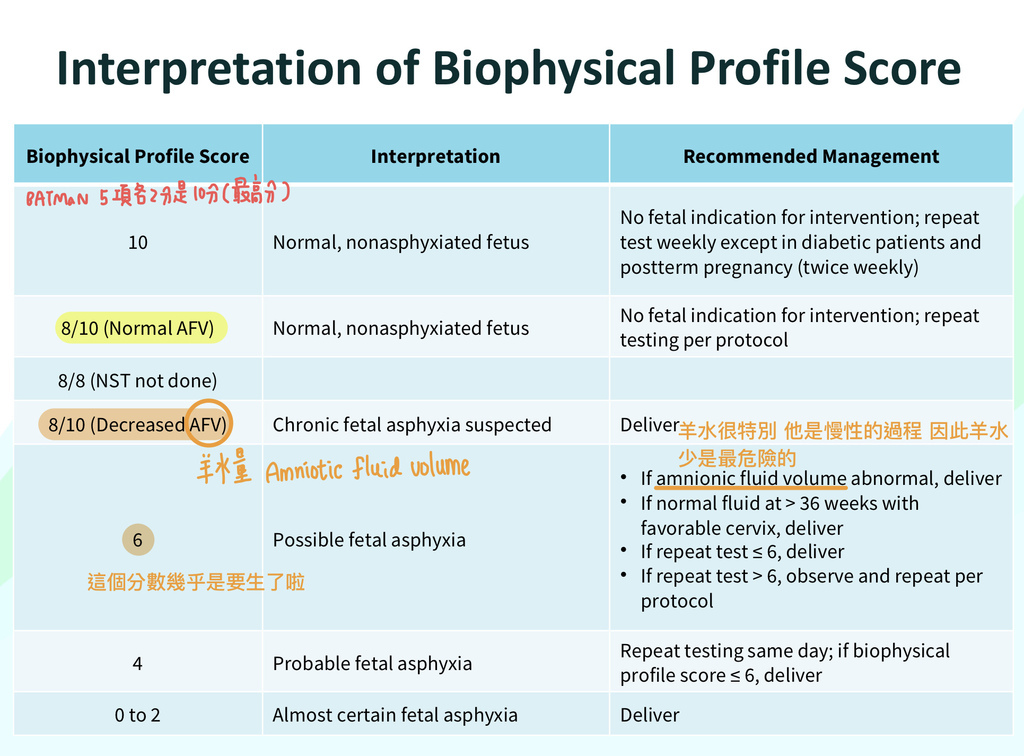三月期
| first trimester | 1-12w |
| second trimester | 13-28w (不是24w喔) |
| third trimester | 29-40w |
早產風險評估 Preterm labor risk screening
- 前胎早產病史
- 胎兒粘連蛋白 (fetal fibronectin, fFN) 陽性
- 子宮頸長度短 (<2.5 cm)
Biophysical profile是決定醫療處置的好方法,

子宮收縮功率 Montevideo Unit (MU) = 每10分鐘宮縮幾次 * 平均宮縮力道(mmHg)
- 第一期產程約 80-120 MU
- 第二期產程約 200-225 MU
胎心音監測 Fetal monitor interpretation
胎心音口訣:BVADC
- Baseline (110-160 bpm)
- Variability (6-25 bpm) : 看震幅
- Accceleration (+)
- Deceleration (-) : early deceleration, late deceleration, variable deceleration
- Category (I) : I 是正常,III 是危險,非 I 非 III 丟到 II。
- 胎兒心音變慢 (<110) 的原因:比較危險
- 胎兒窘迫、胎盤剝離、代謝酸中毒、胎兒缺氧
- 心臟傳導阻斷
- 低體溫
- 若心跳80-120但是variability正常的話仍視為正常沒關係。
- 胎兒心音變快的原因 (>160 bpm)
- 發燒
- 感染
- 胎兒心律不整
- 胎兒變異性減少的原因 (>25 bpm) (marked variability)
- Tachycardia
- 酸中毒
- 中樞系統損傷
- 麻醉止痛藥, MgSO4
- 若合併deceleration訊號應該要積極治療
- 胎兒變異性增加的原因 (<6 bpm) (absent or minimal variability)
- 胎動
- 懷孕週數增加
- 胎兒呼吸造成心律不整
- 出現sinusoidal pattern (類似VF) 就代表嚴重胎兒窘迫要急救了
- 嚴重胎兒貧血 (Rh isoimmunization)
- 顱內出血
- 臍帶壓迫!!!
- 嚴重胎兒缺氧
- 胎心音加速:32周前10bpm維持10秒、32周後15bpm維持15秒。
- 倘若加速維持2分鐘以上叫做 prolonged acceleration
- 倘若加速維持10分鐘以上叫做 baseline change
- 胎心音deceleration
- Early deceleration : 胎頭下降壓迫訊號(代表要開始生產了)
- Late deceleration : 胎盤血流灌流不足
- Variable deceleration : 臍帶壓迫(羊水流失,宮縮會壓迫血管)
- Category I : 必須5項都符合!代表正常
- Baseline 110-160 bpm
- Moderate variability 6-25 bpm
- Acceleration (+)
- Early deceleration (+)
- No late or variable deceleration
- Category II :
- 非1非2即是三,需要密切觀察
- Category III : 符合 1/2:代表異常
- Absent variability (+) +
- Recurrent late deceleration
- Recurrent variable deceleration
- Bradycardia
- Sinusoidal pattern
- Absent variability (+) +
----------------------------------------------------------------------------------------------------
關於第二孕期胎兒頸部囊部水腫 (Cystic hygroma)之發現,最常見的染色體異常疾病為何?
(A) 愛德華氏症 (Edwards Syndrome)
(B) 透納氏症 (Turner Syndrome)
(C) 巴陶氏症 (Patau Syndrome)
(D) 唐氏症 (Down Syndrome)
解析:(D)第一孕期見到cystic hygroma最常見是唐氏症;第二孕期則是Turner。
[補充:心臟疾病有問題最常見的原因是唐氏症]
[補充:Down syndrome有down,所以AFP, PAPP-A會down。相反的b-hCG會up]
----------------------------------------------------------------------------------------------------
關於胎兒心臟 four-chamber view,星號所指之處為何結構?
(A)右心房 (B)右心室 (C)左心房 (D)左心室
解析:左心室
----------------------------------------------------------------------------------------------------
下列何者不是胎兒神經管缺損(Neural tube defeat)?
(A)母血胎兒甲型蛋白(Afp)上升
(B)腦室成淚滴(teardrop)特徵
(C)小腦成香蕉狀(BANANA SIGN)
(D)檸檬頭型(LEMON SIGN)
解析:答案(B)
(A)AFP上升:神經管缺陷 [AFP下降:trisomy 21]
(B)teardrop是胼胝體發育不全
(C)(D)神經管缺陷連帶導致腦袋形狀異常,所以有banana & lemon sign。
----------------------------------------------------------------------------------------------------
下列哪一個染色體異常的風險與孕婦年齡有關?
(A) 愛德華氏症 (Edwards Syndrome)
(B) 柯林菲特氏症(klinefelter Syndrome)
(C) 全染色體三倍體(Triplidy)
(D) 透納氏症 (Turner syndrome)
解析:與孕婦年齡有關的trisomy 21, 18, 13分別是Down, Edward, Patau syndrome,所以答案選(A)。(B)(C)(D)跟年齡都無關。
----------------------------------------------------------------------------------------------------
下列何者不是第二孕期唐氏症四指標(Quadruple test)之檢測項目?
(A) 母血血清胎兒甲型蛋白(Maternal serum AFP)
(B) 非結合性雌三醇(Unconjugated estriol, uE3)
(C) 母血血清標記妊娠相關血漿蛋白(PAPP-A)
(D) 抑制素 A(Inhibin A)
解析:四指標是AFP、b-HCG、Inhibin A、UE3,答案(C)
一唐二指標是PAPP-A、b-hCG
----------------------------------------------------------------------------------------------------
關於第一孕期胎兒超音波檢查,唐氏症篩檢項目不包括下列何者?
(A)頸後透明帶
(B)二尖瓣血流異常
(C)靜脈導管血流異常
(D)鼻骨缺失
解析:一唐=頸部透明帶+PAPP-A+b-HCG,超音波可以看到鼻骨缺陷,靜脈導管血流異常、「右側三尖瓣異常」,答案(B)。
----------------------------------------------------------------------------------------------------
Which of the following cranial ultrasound finding is not associated with neural
tube defect?
(A)cabbage sign
(B)Banana sign
(C)Lemon sign
(D)ventriculomegaly
解析:(A)
----------------------------------------------------------------------------------------------------
What is the most common chromosomal anomaly associated with cystic
hygromas in second-trimester fetuses
(A)Monosomy X
(B)Triploidy
(C)Trisomy 18
(D)Trisomy 21
解析:(A)Monosomy X=Turner syndrome,第二孕期發現cystic hygromas要猜這個病。
----------------------------------------------------------------------------------------------------
Which of the following characteristic is NOT associated with Trisomy 21?
(A) Double-bubble sign
(B) Increased nuchal translucency
(C) Absent nasal bone
(D) Anecephaly
解析:(A)代表十二指腸阻塞,是唐氏症常見的症狀。(B)(C)頸部透明帶增厚、鼻骨塌陷、三尖瓣異常、靜脈導管血流異常是唐氏症常見的症狀。答案(D)無腦症不是唐氏症常見。
----------------------------------------------------------------------------------------------------
Which of the following is NOT a variable commonly used in the biophysical
profile test?
(A) Amniotic fluid volume
(B) Fetal urination
(C) Fetal movement
(D) Fetal breathing
解析:BPP的口訣BATMaN=breathing, AFV, tone, movement, NST這五個項目,沒有urination。答案(B)。
----------------------------------------------------------------------------------------------------
What is the cause of variable deceleration?
(A) head compression
(B) cord compression
(C) hypoxia
(D) academia
解析:造成variable deceleration是嚴重的狀況(catagory III),所以猜測cord compression。
(A)early deceleration[catagory I] (C)(D)late deceleration
----------------------------------------------------------------------------------------------------
This deceleration most likely reflects which of the following?
(A) head compression
(B) cord compression
(C)maternal chronic anemia
(D) uteroplacental insufficiency
解析:本圖片是early deceleration [catagory I],表示head compression胎頭下降。
----------------------------------------------------------------------------------------------------
In 2008, the National Institute of Child Health and Human Development
(NICHD) convened a conference and constructed a three-tiered system for fetal
heart rate pattern classification. Which of the following accurately characterizes
the different tiers?
(A) Category I: absence of early decelerations and presence of normal baseline
variability
(B) Category II: presence of recurrent late decelerations and absent baseline
variability
(C) Category III: presence of recurrent variable decelerations and normal
baseline variability
(D) None of the above
解析:
(A) “present” of early deceleration
(B) “absent” of recurrent late deceleration
(C) “absent” baseline variability
答案(D)。
----------------------------------------------------------------------------------------------------
Which of the following is most commonly associated with placenta abruption?
(A) trauma
(B) short umbilical cord
(C) folic acid deficiency
(D) prior placenta abruption
解析:胎盤早期剝離的危險因子:動過手術、前置胎盤、之前發生過胎盤早期剝離、植入性胎盤、心血管不好
----------------------------------------------------------------------------------------------------
Which of the following is characteristic of a Couvelaire uterus?
(A) requires hysterectomy
(B) contracts adequately with stimulation
(C) results from excessive oxytocin
(D) requires fibrinogen therapy
解析:Couvelaire uterus是經過搶救過後的子宮,還有收縮功能(B)。
----------------------------------------------------------------------------------------------------
Which of the following is a maternal effect of ritodrine?
(A) Hypoglycemia
(B) Hypokalemia
(C) Bradycardia
(D) Hypertension
解析:ritodrine安胎藥(beta-adrenergic agonist)會造成肺水腫、低血鉀,答案選(B)。
----------------------------------------------------------------------------------------------------
Which of the following is not a suitable glucose monitoring item for
preventing fetal macrosomia in woman with Gestational Diabetes (GDM)
(A) Fasting value
(B) Postprandial value
(C) Preprandial value
(D) HbA1c
解析:GDM的篩檢有測fasting, 75g-OGTT, 2階段測試,沒有測HbA1C的。答案(D)。
----------------------------------------------------------------------------------------------------
Which one of the following statements regarding Gestational Diabetes(GDM) is true?
(A) There is no increased risk of postpartum diabetes mellius for the mother if the GDM is well controlled
(B) There is an increased risk for neonatal hypoglycemia
(C) There is not an increased risk for polyhydramnios
(D) There is an increased risk of spontaneous abortion if GDM is well
controlled
(A)錯
(B)對
(C)錯
(D)錯
解析:答案(B),胎兒會有低血糖、黃疸、高膽色素血症、體積過大、難產併發症等。
----------------------------------------------------------------------------------------------------
Which of the following is contraindicated in the treatment of chronic hypertension and pregnancy?
(A) Methyldopa
(B) Hydralazine
(C) Labetalol
(D) Angiotensin converting enzyme inhibitor
解析:有四種妊娠高血壓藥物: Methyldopa, Hydralazine, Labetalol, Nifedipine,答案(D)。
----------------------------------------------------------------------------------------------------
HELLP 症候群( HELLP syndrome )臨床表現不包括下列何者?
(A) 溶血(Hemolysis)
(B) 血小板低下(Low platelet count)
(C) 下腹痛 ( Low abdominal pain)
(D) 肝酵素指數上升( Elevated Liver enzymes)
解析:HELLP=High LDH, Elevated Liver function, Low PLT,答案選(C)。
----------------------------------------------------------------------------------------------------
一位40歲子癲前症孕婦,妊娠35周,因血壓190/120mmHg且發生抽蓄(seizures)被送至急診,請問下列何者為最佳處置?
(A) 立即安排剖腹生產
(B) 給予利尿劑
(C) 給予類固醇促進胎兒肺部成熟
(D) 給予降血壓藥物ACEI (Angiotensin Converting Enzyme Inhibitors)
解析:子癲症 -> 給MgSO4控制症狀,且35周(>34周)並且立刻剖腹。
----------------------------------------------------------------------------------------------------
一位38歲孕婦,第一胎,目前妊娠26週,有高血壓病史,此次產檢血壓 170/110 mmHg,蛋
白尿3價,您認為她最可能的診斷為下列何者?
(A) 慢性高血壓(Chronic Hypertension)
(B) 子癲症(Eclampsia)
(C)子癲前症 (Preeclampsia)
(D)慢性高血壓合併子癲前症(Preeclampsia Superimposed On Chronic Hypertension)
解析:有高血壓病史 -> 血壓懷孕時增加且出現蛋白尿,符合Superimposed。(D)
----------------------------------------------------------------------------------------------------
關於嚴重子癲前症孕產婦的用藥原則,下列敘述何者錯誤?
(A)給予降血壓藥之目的為預防中風,而非降血壓
(B)不可給予降血壓藥 ACEI (Angiotensin Converting Enzyme inhibitors)
(C)建議產後給予Methyl-ergonovine 促進子宮收縮
(D)硫酸鎂(MgSO4)建議使用至產後24小時預防子癲症
解析:(C)高血壓不可以用methergine,會讓血壓更高導致中風。
----------------------------------------------------------------------------------------------------
一位35歲孕婦,妊娠34週,此胎第三胎,早上睡醒發現無痛性大量陰道出血前來急
診,請問您認為最可能的診斷為下列何者?
(A) 前置胎盤 (Placenta previa)
(B) 胎盤早期剝離 (Placental abruption)
(C) 子宮破裂 (Rupture of uterus)
(D) 早期破水 (Premature rupture of the membranes)
解析:無痛陰道出血 = 前置胎盤。
----------------------------------------------------------------------------------------------------
一位40歲產婦在生產過程使用真空吸引輔助生產,在產後第一天發生大量出血,經初
步評估子宮收縮良好,您認為下列何者是最有可能導致出血之原因?
(A)凝血功能異常(Coagulation Defects)
(B)產道撕裂傷(Lacerations of genital tract)
(C)胎盤組織殘留(Retained placenta)
(D)異常胎盤附著(Abnormal placentation)
解析:排除子宮異常(C)(D),且凝血疾病應該當下就處理好,因此選(B)。
----------------------------------------------------------------------------------------------------
下列何項超音波檢查發現最可能與染色體數目異常(aneuploidy)有關?
(A)臍膨出 Omphalocele
(B)腹壁裂 Gastroschisis
(C)軟骨發出不全症 Achondroplasia
(D)肛門閉鎖 Anal atresia
解析:(A)就是有關
(B)是發育異常但是與基因無關。(C)侏儒症,除了體顯遺傳,還有可能是FGFR3 mutation
----------------------------------------------------------------------------------------------------



 留言列表
留言列表